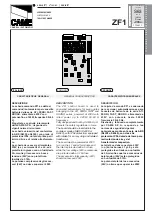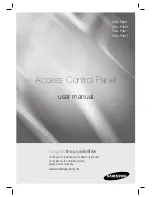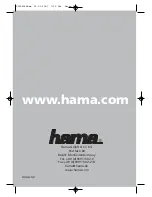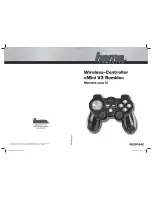
PK-232 TECHNICAL MANUAL
APPENDIX A – AX.25 LEVEL 2 PROTOCOL
PK232TM Rev. A 5/87
A-13
Page 58
A.3.4.3.1
Set Asynchronous Balanced Mode (SABM) Command
The SABM command is used to place 2 DXEs in the asynchronous balanced mode. This is a bal-
anced mode of operation known as LAPB where both devices are treated as equals.
Information fields are not allowed in SABM commands. Any outstanding I frames left when the
SABM command is issued will remain unacknowledged.
The DXE confirms reception and acceptance of a SABM command by sending a UA response frame
at the earliest opportunity. If the DXE is not capable of accepting a SABM command, it should re-
spond with a DM frame if possible.
A.3.4.3.2
Disconnect (DISC) Command
The DISC command is used to terminate a link session between two stations. No information field
is permitted in a DISC command frame.
Prior to acting on the DISC frame, the receiving DXE confirms acceptance of the DISC by issuing a
UA response frame at its earliest opportunity. The DXE sending the DISC enters the disconnected
state when it receives the UA response.
Any unacknowledged I frames left when this command is acted upon will remain unacknowledged.
A.3.4.3.3
Frame Reject (FRMR) Response
A.3.4.3.3.1
The FRMR response frame is sent to report that the receiver of a frame cannot successfully proc-
ess that frame and that the error condition is not correctable by sending the offending frame
again. Typically this condition will appear when a frame without an FCS error has been received
with one of the following conditions:
1. The reception of an invalid or not implemented command or response frame.
2. The reception of an I frame whose information field exceeds the agreed-upon length. (See
A.4.7.3
, below.)
3. The reception of an improper N(R). This usually happens when the N(R) frame has already
been sent and acknowledged, or when N(R) is out of sequence with what was expected.
4. The reception of a frame with an information field where one is not allowed, or the reception
of a U or S frame whose length is incorrect. Bits W and Y described in
A.3.4.3.3.2
should both
be set to one to indicate this condition.
5. The reception of a supervisory frame with the F bit set to one, except during a timer recovery
condition (see
A.4.4.9
), or except as a reply to a command frame sent with the P bit set to
one. Bit W (described in
A.3.4.3.3.2
) should be set to one.
6. The reception of an unexpected UA or DM response frame. Bit W should be set to one.
7. The reception of a frame with an invalid N(S). Bit W should be set to one.
An invalid N(R) is defined as one which points to an I frame that previously has been transmitted
and acknowledged, or an I frame which has not been transmitted and is not the next sequential I
frame pending transmission.
An invalid N(S) is defined as an N(S) that is equal to the last transmitted N(R)+k and is equal to
the received state variable V(R), where k is the maximum number of outstanding information
frames as defined in
A.4.7.4
below.
Summary of Contents for PAKRATT PK-232
Page 75: ...PK 232 TECHNICAL MANUAL APPENDIX C DRAWINGS PK232TM Rev A 5 87 C 1 Page 75 ...
Page 76: ...PK 232 TECHNICAL MANUAL APPENDIX C DRAWINGS PK232TM Rev A 5 87 C 2 Page 76 ...
Page 77: ...PK 232 TECHNICAL MANUAL APPENDIX C DRAWINGS PK232TM Rev A 5 87 C 3 Page 77 ...
Page 78: ...PK 232 TECHNICAL MANUAL APPENDIX C DRAWINGS PK232TM Rev A 5 87 C 4 Page 78 ...
Page 79: ...PK 232 TECHNICAL MANUAL APPENDIX C DRAWINGS PK232TM Rev A 5 87 C 5 Page 79 ...
Page 80: ...PK 232 TECHNICAL MANUAL APPENDIX C DRAWINGS PK232TM Rev A 5 87 C 6 Page 80 ...
Page 81: ...PK 232 TECHNICAL MANUAL APPENDIX C DRAWINGS PK232TM Rev A 5 87 C 7 Page 81 ...
Page 82: ...PK 232 TECHNICAL MANUAL APPENDIX D Waveforms PK232TM Rev A 5 87 D 1 Page 82 ...
Page 83: ...PK 232 TECHNICAL MANUAL APPENDIX D Waveforms PK232TM Rev A 5 87 D 2 Page 83 ...
Page 84: ...PK 232 TECHNICAL MANUAL APPENDIX D Waveforms PK232TM Rev A 5 87 D 3 Page 84 ...
Page 85: ...PK 232 TECHNICAL MANUAL APPENDIX D Waveforms PK232TM Rev A 5 87 D 4 Page 85 ...
Page 86: ...PK 232 TECHNICAL MANUAL APPENDIX D Waveforms PK232TM Rev A 5 87 D 5 Page 86 ...
Page 87: ...PK 232 TECHNICAL MANUAL APPENDIX D Waveforms PK232TM Rev A 5 87 D 6 Page 87 ...
Page 88: ...PK 232 TECHNICAL MANUAL APPENDIX D Waveforms PK232TM Rev A 5 87 D 7 Page 88 ...
Page 89: ...PK 232 TECHNICAL MANUAL APPENDIX D Waveforms PK232TM Rev A 5 87 D 8 Page 89 ...
Page 90: ...PK 232 TECHNICAL MANUAL APPENDIX D Waveforms PK232TM Rev A 5 87 D 9 Page 90 ...
Page 91: ...PK 232 TECHNICAL MANUAL APPENDIX D Waveforms PK232TM Rev A 5 87 D 10 Page 91 ...
Page 92: ...PK 232 TECHNICAL MANUAL APPENDIX D Waveforms PK232TM Rev A 5 87 D 11 Page 92 ...
Page 93: ...PK 232 TECHNICAL MANUAL APPENDIX D Waveforms PK232TM Rev A 5 87 D 12 Page 93 ...
Page 94: ...PK 232 TECHNICAL MANUAL APPENDIX D Waveforms PK232TM Rev A 5 87 D 13 Page 94 ...
Page 95: ...PK 232 TECHNICAL MANUAL APPENDIX D Waveforms PK232TM Rev A 5 87 D 14 Page 95 ...
Page 96: ...PK 232 TECHNICAL MANUAL APPENDIX D Waveforms PK232TM Rev A 5 87 D 15 Page 96 ...
Page 97: ...PK 232 TECHNICAL MANUAL APPENDIX D Waveforms PK232TM Rev A 5 87 D 16 Page 97 ...
Page 98: ...PK 232 TECHNICAL MANUAL APPENDIX D Waveforms PK232TM Rev A 5 87 D 17 Page 98 ...
Page 99: ...PK 232 TECHNICAL MANUAL APPENDIX D Waveforms PK232TM Rev A 5 87 D 18 Page 99 ...
Page 100: ...PK 232 TECHNICAL MANUAL APPENDIX D Waveforms PK232TM Rev A 5 87 D 19 Page 100 ...
Page 101: ...PK 232 TECHNICAL MANUAL APPENDIX D Waveforms PK232TM Rev A 5 87 D 20 Page 101 ...
















































